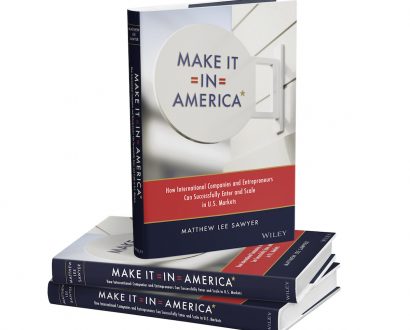Scaling in the States: Why & how to bring your business to North America

Business and marketing strategy consultant Matthew Lee Sawyer, an expert commentator on scaling companies, believes that "the United States is a great place to do business".
"It has the largest market, it’s friendly in terms of financing, the government systems are fairly pro-business," he explains.
The list goes on. Since its founding, the United States has called to people from all corners of the globe, encouraging and challenging them to go to the country and build new lives, new businesses, new futures.
"It’s part of American history," Sawyer says. "It’s our heritage and in our DNA. The country was built by immigrants and there have been several waves of immigrants since."
In fact, he points out, the majority of the top 500 companies were either started by immigrants or children of immigrants. The tech field in particular has a very high incidence of international founders.
In addition to being a place where foreign-based businesses have the opportunity to gain a foothold and flourish, Sawyer notes that America benefits, too. "The country needs the challenge, the industry to keep growth up," he says. "We need the enthusiasm and energy of people entering the marketplace."
Think of countries like China and Japan – some of, if not the most rapidly aging societies in the world – where there is currently a drain of younger people, which creates stagnation and a drain on the economy. While the United States is not exactly in that situation, America does not want to find itself heading there.
The United States has long been and remains a very strong economy, but in the short-term Sawyer acknowledges there are challenges regarding inflation, employment and companies trying to right themselves after recent years of both domestic and global turmoil. "But if you take a longer-term perspective, the United States is, by far, the largest, most stable economy in the world," he says.
A 2020 article, written by Chief Global Strategist at Morgan Stanley Investment Management Ruchir Sharma for <em>Foreign Affairs</em>, mentions that North America’s share of the global economy – which is roughly 25 percent – has held steady for the past four decades. Over the last 150 years, there have been more than 30 recessions, but only one depression.
"We always come back," Sawyer says. The culture of being open for business helps the country to flourish, too.
The origins of Make It in America

For 25 years, Sawyer worked in management roles and marketing agencies for several successful companies, including BIC USA and Snapple Beverages. Later, he worked for two digital technology startups.
About 10 years ago, through his consulting, university teaching and interactions with European American Chambers of Commerce, he came across several international companies with highly successful businesses in other parts of the world. "But when they came to the United States, they struggled," Sawyer says. It was difficult to grasp the complex business culture, the competitiveness and American consumer demand.
At the time, there seemed to be remarkably little information about bringing a business stateside – a handful of lackluster articles, some listicles and checklists. Certainly nothing explaining the whys – why each of the country’s regions is so different than the others or why the legal system works the way it does.
With nothing to steer companies through the intricacies of United States business, there was a clear need for a definitive guide.
Through a database for an accelerator group, Sawyer sent out a questionnaire to gather some quantitative research – obstacles faced, knowledge gaps, critical skills – and found a few different topics for which guidance was needed. Next came in-depth interviews with people from 40 different countries – entrepreneurs, founders and subject matter experts.
His notes formed thesis-like write-ups, which became the book’s 12 chapters, covering topics from the importance of timing to visas. "I created this guide because I really wanted to help people," Sawyer says.
Scaling businesses: Foreign entrepreneurs must be committed and prepared to ‘do their homework’
Roughly 10 years ago, after leaving Jetstar where he was the CEO, Australian businessman Bruce Buchanan started a software company called Rokt. He developed it and initially tested it in Australia, New Zealand and Singapore before bringing it to the United States – subsequently moving there with his family to fully entrench himself in the market.
His story is an inspiration to Sawyer, who admires Buchanan’s commitment. More than anything else, Sawyer says, for success in the States, foreign businesses and entrepreneurs need dedication, resilience and perseverance.
They need to be able to push through those times when, in Buchanan’s words, "Things are going to be bloody tough."
Another expert whose guidance Sawyer sought out is Dietmar Rieg, President of the German American Chamber of Commerce. Rieg recommends entrepreneurs do their homework to understand the competitive landscape and the consumer.
"They have to recognize that the situation is different here in America," Sawyer says. "What made them successful in their home country might not work in the United States."
On one hand, consumers in the States are more demanding than just about anywhere else. They have so many options, they’re only going to buy things that are great, that really meet their needs. On the other, they’re very open to discovery and trying new things, Sawyer says.
He recommends being strategic about opening up into different areas: "The best strategy is to identify a promising market, establish a presence – and learn from it – before expanding."
Foreign entrepreneurs must seek to understand Americans
Chapter nine of the book is dedicated to understanding Americans – the way they think, feel and act, as well as their unique business mindset.
Having grown up in the States, Sawyer leaned on the objectivity of outside experts and the renowned Hofstede Insights, an organization that studies cultural differences.
What came up in the research was the somewhat intimidating communication style for which the United States is known. "In some ways, we’re pretty easy to understand because we go for clarity; we tell it like it is," Sawyer says.
"It’s such a diverse country, with people coming from so many different backgrounds, that communication needs to be very straightforward and easy to understand."
Another point was the sense of individualism, as opposed to collectivism, that permeates almost every aspect of American life. Sawyer highlights a quote from Hofstede’s Lisa DeWaard: "Americans want to be entrusted with the task at hand, but they also want to be free to do it in their own way."
The United States scored higher than any other nation for individualism, Sawyer writes, which amounts to a business style, a lifestyle, that’s very different from other countries.
Foreign entrepreneurs must paint a picture of success
One of the first things to determine as part of the overall strategy is, "What does success look like? What does it mean to win?" For one company, that may be monetary gain; for another, it may be mission-driven or doing something positive for the world.
Once success is defined, the work begins. Sawyer acknowledges it isn’t easy to come to the States. There can be a lot of hurdles and frustrations. But at the end of the day, he writes, it’s worth it.
For Sawyer, the American Dream is real.
"But it’s not about getting fabulous amounts of money and fame," he says. "It’s more that you can choose what you want to achieve; you have the opportunity to live out the life you want. And I think that’s the greatest part of the country."
A success story
Too Good To Go is an app that helps reduce food waste. People have the chance to buy discounted food from restaurants and bakeries at the end of the day, before an enormous amount of unsold food is thrown away.
It got started in Denmark and, from there, expanded to other countries in Europe before landing in the United States. Once established in New York, the team saw they had to adjust what they were doing in Europe to suit an American user base.
After New York, it expanded – with great success – into San Francisco and Boston.